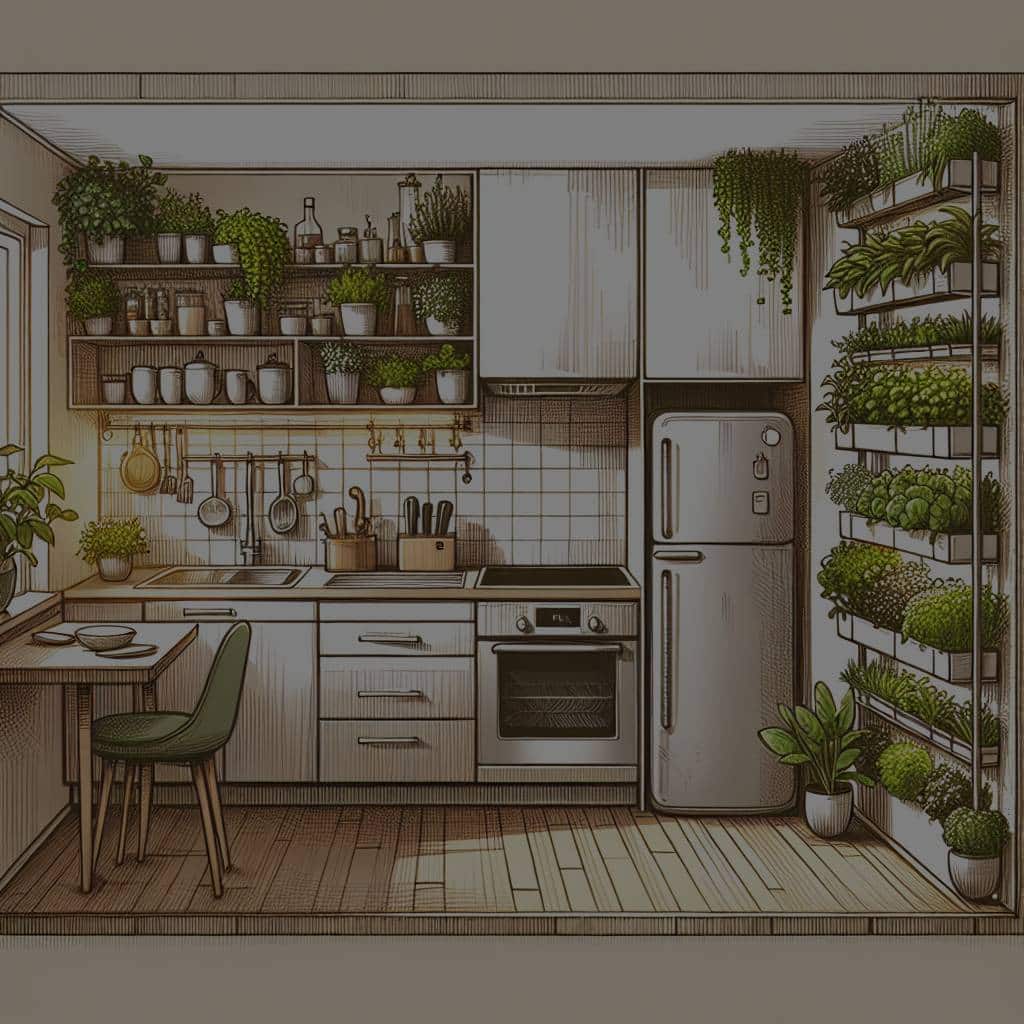What’s the Best Method to Integrate a Vertical Herb Garden in a Compact Apartment Kitchen?

The urban lifestyle, with its ever-shrinking living spaces, often means compromising on the luxury of having a garden. But what if we told you that you could have your cake and eat it too? Or, in this case, have your garden and cook with it too? Enter the game-changer – a vertical herb garden. It’s a unique and practical way of integrating greenery into your home, specifically your kitchen, without requiring a large space. This gardening method is not only a great way to grow herbs, but it also adds an aesthetic element to your indoor environment. So, let’s dive in to explore the best method to set up your very own vertical herb garden in a compact apartment kitchen.
Choosing the Perfect Spot for Your Vertical Herb Garden
To start off, the first crucial step in setting up a vertical herb garden is choosing the right spot. Ideally, this spot should receive ample sunlight as most herbs require at least six hours of sunlight per day to grow well.
A lire en complément : How Can You Optimize Indoor Air Quality with Smart Ventilation Systems?
Look for a wall that receives morning light and is not too hot in the afternoon. If natural light is limited, fluorescent or grow lights can be a good alternative. Remember, the closer the garden is to your cooking area, the easier it will be for you to pick fresh herbs while preparing meals.
You could also use the vertical space on the side of your refrigerator or a tall, free-standing shelf. The idea is to optimize your space without cluttering your kitchen.
Sujet a lire : How to Design a Home Entryway for Efficient Space Utilization and Aesthetic Appeal?
Selecting Suitable Herbs and Plants
Not all herbs are created equal. Some plants will thrive in your indoor garden, while others might struggle. When choosing herbs, consider ones that are used frequently in your kitchen. This could include basil, parsley, cilantro, thyme, or chives.
The size of the plant is also an important factor. Compact herbs like thyme, oregano, or chives are space-efficient, while larger plants like rosemary or mint might require more room to grow.
Also, consider the growing conditions each herb prefers. Some herbs, like basil or parsley, prefer moist soil, whereas others, like thyme or rosemary, prefer drier conditions.
The Right Vertical Planter for Your Herb Garden
Vertical planters come in various types and sizes. Some common types include wall-mounted planters, hanging planters, and free-standing vertical planters. Your choice should be influenced by the available space, your budget, and of course, your personal taste.
Wall-mounted planters can be a great space-saver. They attach directly to the wall and can hold multiple pots. Hanging planters can be suspended from the ceiling or a wall bracket. They add a dynamic element to your kitchen and are easier to move around if needed. Free-standing vertical planters can be placed anywhere in your kitchen, provided they receive enough light.
Care and Maintenance of Your Vertical Herb Garden
Vertical gardens require a slightly different approach to care and maintenance than traditional ground-level gardens. Watering, for instance, needs to be done carefully. Water from the top and let it trickle down to ensure all the plants receive enough water. However, be careful not to overwater, as this can lead to root rot.
Pruning is also a crucial part of maintaining a healthy herb garden. Regularly cutting back your herbs encourages new growth and prevents them from becoming too leggy.
Finally, it is essential to rotate your plants occasionally to ensure they get equal light exposure. This is particularly important if your light source comes from one direction.
The Role of Soil in Your Vertical Herb Garden
The soil you use in your vertical herb garden plays a pivotal role in the success of your plants. It’s responsible for providing your herbs with all the nutrients they need to grow.
A good-quality potting mix that is light and well-draining is essential. This type of soil ensures your plants get adequate water without becoming waterlogged. Some herbs also prefer slightly acidic soil, so it might be beneficial to add a bit of peat moss to your potting mix.
Remember to feed your herbs regularly with organic compost or a slow-release fertilizer to replenish nutrients.
In summary, setting up a vertical herb garden in your kitchen is a brilliant way to make the most of your space while adding a touch of nature to your home. With careful planning and regular care, you can grow a thriving garden and have fresh herbs at your fingertips whenever you need them. That’s urban gardening done right!
Incorporating Aesthetics into Your Vertical Herb Garden
Aesthetic appeal is an added advantage of having a vertical herb garden in your kitchen. While the primary purpose is to grow herbs, the garden can also serve as a beautiful and refreshing decor piece.
Start by choosing a planter that complements your kitchen’s style and color scheme. A variety of options are available in the market, ranging from rustic wooden boxes to chic metal frames. You can also repurpose common household items like mason jars, old ladders, or pallets to create a unique and eco-friendly planter.
Next, arrange your herbs thoughtfully. You could alternate between different types of herbs to create a pattern or group them according to their color and texture. Remember to leave enough space between the plants to allow them to grow freely.
Accessories like decorative pots, cute garden labels, or fairy lights can add a personal touch to your herb garden. However, be mindful not to overdo it and distract from the natural beauty of your herbs.
Don’t forget to consider practicality alongside aesthetics. Your garden should be easy to maintain and not impede your cooking activities. For instance, hanging baskets should be hung at a height where they are easily accessible but do not interfere with your cooking space.
Finally, consider the view from various angles. Since your garden will be a focal point in your kitchen, it should look good from all sides.
Conclusion: Embrace Vertical Gardening for Fresh Herbs All Year Round
In conclusion, creating a vertical herb garden in your kitchen is an exciting and rewarding endeavor that lets you grow your favorite herbs in a small space. This urban gardening solution not only brings the joy of greenery into your home but also elevates the aesthetics of your kitchen.
Getting started might seem daunting, but with careful consideration of the location, selection of appropriate herbs, the right planter, and regular care, you can soon have a flourishing vertical garden. Moreover, the convenience of having fresh herbs at your disposal makes the effort truly worthwhile.
Remember, regular maintenance is the key. Ensure that your plants get enough light, water, and nutrients. Rotate them regularly for equal light exposure and prune them to promote growth.
Having a kitchen herb garden ensures you have fresh ingredients for your meals year-round. Plus, gardening can be a great stress-reliever and an opportunity to engage with nature, even in a concrete urban setting.
So, embrace vertical gardening and let your love for herbs and plants grow!
Photo credit: All images used in this article are credited to their respective sources.
